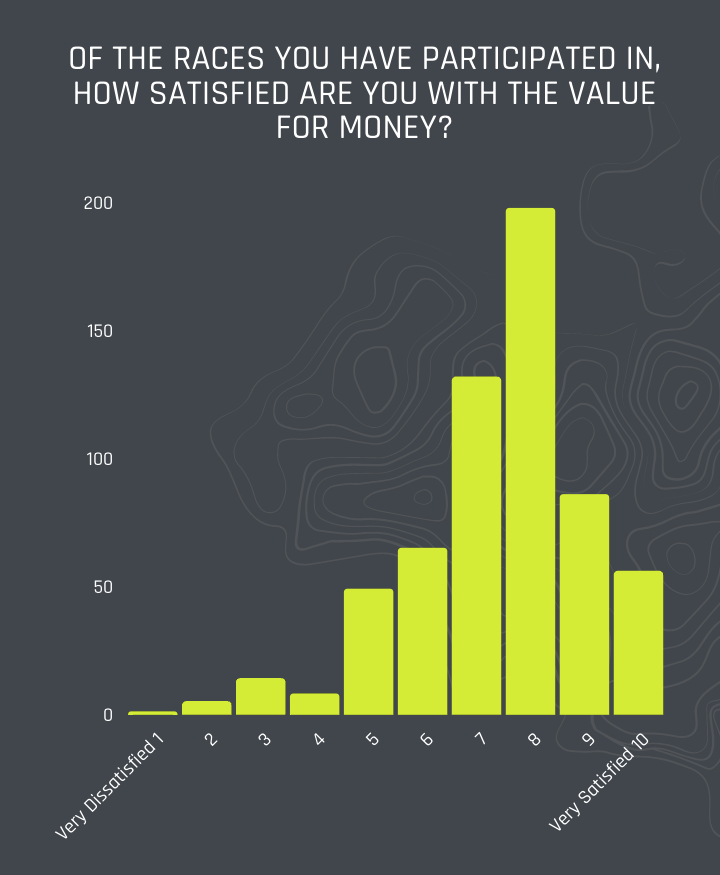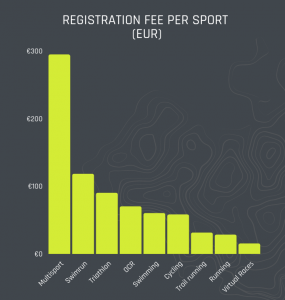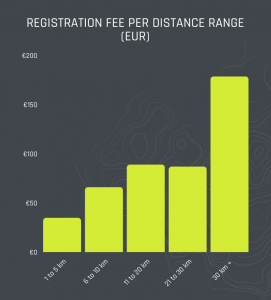What Should A Race Cost? How To Set Your Registration Fee

Pricing for endurance races can be tricky – if you price your race too high, no one wants to sign up. If you price your race too low on the other hand, you risk not breaking even for unforeseen costs and other factors. In this post, we help you set the right registration fee for your race, from both the organizing cost perspective, the current market and what participants consider the right price.
Calculate Your Cost Per Participant And Your Break-Even Point
The first thing you need to do is to make a budget and roughly estimate all the fixed and/or dynamic costs you have for your race. You can do that with this Free Cost Calculator and Budget Template. Once you know the total cost for marketing, timekeeping, food, arena material etc, you can break it down into a cost per participant. Also include any other per participant cost such as registration and payment payment processing, timekeeping and meals. You should then have a cost per participant which is a minimum indication of how much you need to charge to break-even with your race and also how many participants you need to break-even.
Sometimes, it can be hard to estimate costs if you don’t know the exact number of participants. Make sure you plan for the “worst-case” scenario and don’t be an optimist when it comes to finances. It will cost you in the long run!
Determine Your Margin And Set Your Final Fee
Step 2 is to decide your margin and set the final price that participants need to pay. This step is dependent on three things: your goals and ambitions with the business of your race, how well you will be able to create demand for race spots (how popular your race is, or becomes), and the features or benefits you offer participants.
Goals And Ambitions With Your Race Business
Why are you organizing a race? Are you making a living out of it? Do you just do it as a hobby and don’t care about making any profit? Do you do it for charity and want to donate as much as possible to your cause? The goals and ambitions with your race has a big impact on the final outcome and how much time and resources you have to spend on making it great. Figure out what you want with your race, and decide how much money you would like to end up with at the bottom line. Then, use the next two steps to make it happen.
Create Demand For Race Spots
The fee you can take, also depends on how popular your race is, and your own skills in promoting it. If you have a limited number of spots and a lot of racers want those spots, you can probably set a higher price than if you are just starting out and need to get as many new racers to try your race as possible to create traction.
We would suggest you include a marketing budget in your planning, so you can put some effort into promoting your race to make it more popular in your sport communities. Start early to create a hype around your race!
Remember you may also want to consider, in the whole cost scheme of things, to include extra margin for free spots you may give away to top athletes, celebrities and sponsors, as well as club discount codes and early-bird pricing ladders. This can greatly help you fill up spots and create that sense of urgency to sign up due to FOMO.
Features & Benefits for Participants
As an athlete, the more stuff you get in a race, the more you are willing to pay. If you offer medals, finisher T-shirts, meals etc, it is a reason to have a higher entry fee. It is crucial that you communicate clearly on your website and also on your registration page, exactly what the race entry fee includes. Use bullet points!
If you offer a complete package with a full board and a place to sleep, you need to have a higher price of course, and participants will understand that. Signing up for the World Champs of Swimrun costs 1300 EUR per 2-person team, but it also includes a 2-night stay at premium hotels gourmet meals and safety and support along a 75-km course. A Triathlon can cost up to 500 EUR just for an entry fee – this is generally perceived as high, but the costs to organize a long race are much higher in terms of security and preparation of such a long course, so longer races often have a higher fee and this is also generally accepted among participants – given that the benefits are clearly communicated. Take all these aspects into consideration, and determine the price you can offer in exchange for everything that you give your participants.
If you look at the general market, most racers perceive they get a good value for their money participating in Endurance races (see graph below).

Benchmark on Competitors, the Local Market and Your Sport
It is important you are not too far away from the pricing expected by participants in your specific market. Make sure you benchmark against other races around you. To help you out, we aggregated some data from the RaceID platform, showing average registration fees based on sport and distance (click on the images to see the graphs in a larger format). Obviously, factors such as race-transportation, accommodation, meals, etc can have a big impact on these numbers – so use them as a guide rather than a rule! Instead, check the fees on some races around you and see if you are in that right ball-park. If not, go back and see how you can reduce costs if you are too high, and consider adding some margin if you are much lower. However, competing on a lower price point can also give you an advantage over competitors 😉
- Registration Fee Per Sport
- Registration Fee Per Distance
Add VAT and Tax According to Your Country’s Specifications
An important last step to remember, is to also calculate the VAT on the listed price, if applicable. Some countries have a VAT fee for endurance races at 6-25 % and some countries don’t require you to pay VAT or sales tax at all. The easiest way to do this is to simply add the VAT on top of the final price you came up with, and there you have your final fee, to configure into your entry system! Please note, that the suggestions and ideas presented in this article are only guidelines – when you set your registration fee and VAT, make sure you consider multiple factors and check with your local laws and regulations regarding taxes applicable.
We hope this gives you an idea of which factors play a part in the pricing of a race, and help you set a reasonable registration fee. For any further questions, don’t hesitate to get in touch.




